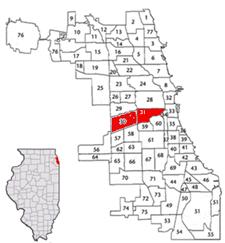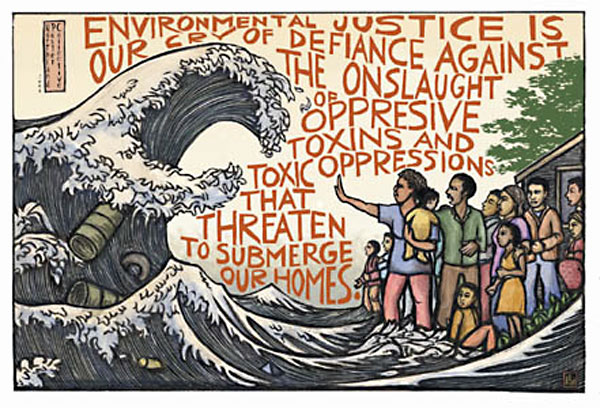 |
 |
 |
 |
Environmental Justice: United States Cases |
|---|
Below are a select number of urban domestic EJ case studies. These particular cases were selected because they are all:
Two cases focus on New York City because, as NYC residents, the authors of the site feel particularly connected to these issues. With the exception of New Orleans, the cases represent EJ issues that are not unique to any one city. |
Illustration by: Ricardo Levins Morales |
|---|
Coal-Burning Power Plants in Chicago’s Two Mexican-American Neighborhoods
Location and Context: Chicago, IL
Specifically the two Mexican-American neighborhoods on the southwest side: Little Village (30 on map) and Pilsen (31).

Map courtesy of http://www.northwestern.edu/fup/The%20Experience/Maps/Pilsen.html & edited by Julie Raskin
Problems and Conflicts: Two heavily polluting, coal-burning power plants provide Chicago with most of its energy, yet disproportionately burden the local population with numerous environmental and health problems.
Issues and Claims:
-Little Village and Pilsen suffer numerous social and economic burdens: Little Village is the most densely populated neighborhood in Chicago, has the City’s youngest median age, faces severe overcrowding in its public schools, and is among the poorest community areas in the City, with 22% of the families below the poverty level and an unemployment rate of 11%. Pilsen shoulders similar burdens.
-Pollution from the power plants further contributes to these burdens by creating significant health problems in these communities.
-Research done by the Harvard School of Public Health in 2001 showed that the pollution from these two plants causes 41 premature deaths, 2800 asthma attacks, and 550 emergency room visits each year.
-The community is demanding that these power plants take simple measures to update their facilities and reduce pollution.
-Unfortunately, the community has no legal leverage because both plants were built before many of the EPA’s clean air regulations, and are permitted to continue using their outdated, heavily polluting equipment.
-The City of Chicago refuses to put pressure on the plants to use cleaner technology.
Stakeholders: Midwest Generation (owns the power plants), Little Village Environmental Justice Organization (http://www.lvejo.org/coalpower.htm)
(represents community in struggle against the plants), Chicago Clean Power Coalition (http://www.chicagocleanpower.org/) (coalition of groups working against the plants), American Lung Association of Metropolitan Chicago (http://www.lungchicago.org/site/epage/36654_487.htm) (supports the community struggle to clean up the plants)
Unequal Distribution of Open Space in New York City
Location and Context: New York City, NY.
Problems and Conflicts: New York City has one of the lowest ratios of open space to residents in the country, and open space resources are unequally distributed, severely disadvantaging minority and low-income communities.
Issues and Claims:
-GIS mapping conducted by the NYC Environmental Justice Alliance revealed pronounced inequalities:
-In 37 of the 59 community districts, the City’s standard for open space (2.5 acres per 1000 residents) is not being met
-Of these 37 underserved community districts, 24 are in the highest minority category and 18 are in the lowest median household income category
-
In Hunts Point in the South Bronx, which is one of the poorest neighborhoods in the country, only 1.9% of land is used for park space
-
Many of these underserved communities are forming grassroots movements to fight for increased open space
-
A coalition of community groups in Hunts Point has won support for a bicycle/pedestrian greenway along the South Bronx waterfront; construction is set to begin shortly.
Stakeholders: This issue affects low-income and minority neighborhoods across the City. For more information on the issue in general, or to find out more about Hunt’s Point, visit:
- New York City Environmental Justice Alliance (http://www.nyceja.org/campaigns.html)
- New Yorkers For Parks (www.parks1.org)
- Sustainable South Bronx (http://www.ssbx.org/greenway.html)
Inequity in the Siting of Waste Transfer Stations in New York City
Location and Context: New York City, NY
- Waste transfer stations are sheds where garbage trucks dump trash so that larger trucks can pick it up and carry it out of the area.
- Since the closing of Fresh Kills—New York City’s only municipal landfill—in 2001, the City exports all of its garbage to landfills in neighboring states, making transfer stations a critical part of the waste management system
Problems and Conflicts: Transfer stations are integral to waste management in NYC, yet they are highly-polluting and disproportionately burden minority and low-income communities.
Issues and Claims:
- Transfer stations are unsightly and noxious, and cause pollution from the associated diesel truck traffic
- This pollution has severe adverse effects on the health of the local community, causing extremely high rates of asthma in the surrounding neighborhoods
- Though transfer stations are located throughout the City and state, New York City Environmental Justice Alliance found that the majority are clustered in low-income and minority communities
- For example, 37% of NYC’s waste travels through 15 transfer stations in the South Bronx—which is a largely minority community and part of the poorest congressional district in the country
Stakeholders: Several community and City-wide EJ groups are working to address this inequality, including
- New York City Environmental Justice Alliance (http://www.nyceja.org/campaigns.html)
- Organization of Waterfront Neighborhoods (http://www.cobbmedia.com/garden/own.html)
- Sustainable South Bronx (http://www.ssbx.org/solid_waste.html)
- The rebuilding process is taking a long and receiving little federal attention or money. EJ advocates claim that were New Orleans a predominantly white city, the rebuilding process would be more efficient and would receive more federal attention.
- Officials are considering not rebuilding in many of the predominately African-American neighborhoods, such as New Orleans East and the Lower Ninth Ward, even though these areas are more elevated—and thus less prone to flooding—than some of the white neighborhoods that are being rebuilt.
- The EPA has given New Orleans a clean bill of health and allowed residents (mostly African-American) to move back into areas that are heavily polluted and contaminated. The EPA supports its decision by arguing that these areas were contaminated before the storm and are no worse now. In doing this, the EPA is shirking its responsibility to protect the people, and forgoing an opportunity to clean up these neighborhoods.
Environmental Injustice in Post-Katrina New Orleans
Location and Context: New Orleans, LA.
Problems and Conflicts: The rebuilding of New Orleans after the storm has been conducted in a way that has been discriminatory against the low-income, African-American population.
Issues and Claims: EJ activists and community leaders in New Orleans see many instances of environmental injustice in the rebuilding process:
Stakeholders: The Environmental Justice Resource Center at Clark Atlanta University (http://www.ejrc.cau.edu/Katrinaupdate.html) (Research Center working to address environmental injustices), The Deep South Center for Environmental Justice (http://www.dscej.org/index.html) (Research Center in New Orleans working to address environmental injustices), The U.S. Environmental Protection Agency (http://www.epa.gov/katrina/)



